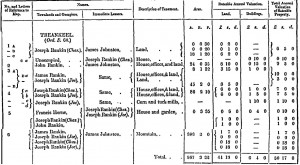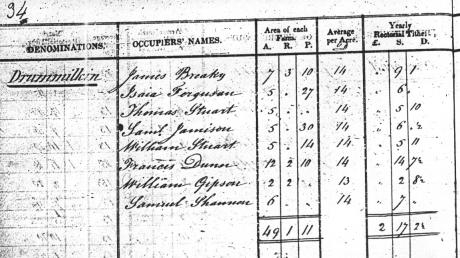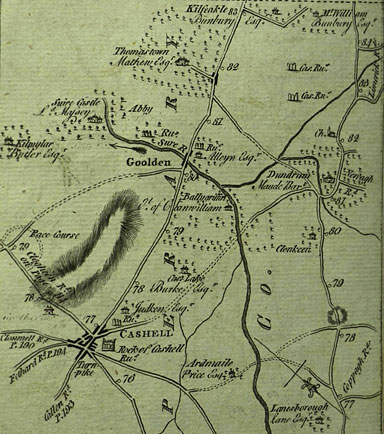LEARN MORE›››
Irish Land Records – Census Substitutes
Before using Irish land records, it is important to understand how land was organised by the civil authorities in the 19th century.
The smallest division was the townland, and this was usually the address recorded on a civil certificate or census return. Townlands were grouped into civil parishes. It is important to note that the boundaries and names of civil parishes usually differed from those of Catholic parishes.
Civil parishes were organised into Baronies and then Counties. The 1901 and 1911 census are organised by DED (District Electoral Division). If you identify a family in the 1901 and 1911 census you can use the House and Building Return (Form B1) or Enumerators Return (Form N) to identify the civil parish in which the townland is located. At the top of each form you will find the name of the Poor Law Union, District Electoral Division, Townland and Civil Parish. The links for these forms are found below the original census return on the National Archives website.
The majority of 19th century census returns for Ireland no longer survive. In the absence of these records, it is necessary to use other sources as ‘census substitutes’. These ‘census substitutes’ can be used to identify earlier generations of your family.
Irish Land Records – Griffith’s Valuation
 The most valuable ‘census substitute’ used by genealogists is the Primary Valuation of Ireland, also known as Griffith’s Valuation. Griffith’s Valuation was a nationwide survey of property taken between 1847 and 1864 for the purpose of assessing the rate of local taxation. The tax was levied for the upkeep of the poor and destitute of the parish. As a substitute for the lost 1851 Census, Griffith’s Valuation identifies nearly every household in the country, recording the head of that household, the name of their landlord (immediate lessor) and the type, size and value of their property.
The most valuable ‘census substitute’ used by genealogists is the Primary Valuation of Ireland, also known as Griffith’s Valuation. Griffith’s Valuation was a nationwide survey of property taken between 1847 and 1864 for the purpose of assessing the rate of local taxation. The tax was levied for the upkeep of the poor and destitute of the parish. As a substitute for the lost 1851 Census, Griffith’s Valuation identifies nearly every household in the country, recording the head of that household, the name of their landlord (immediate lessor) and the type, size and value of their property.
Griffith’s Valuation can be consulted online at Findmypast (subscription) and Ask About Ireland (free). Try to familiarise yourself with the search engines of both websites, as you can often come up with different results, depending on the site that you use. Both websites will only search for the exact spelling of a surname or place name unless you specify a broader search.
The object of your search is to find your ancestor’s land holding recorded in Griffith’s Valuation, as this will tell you exactly where they were living in the mid 19th century. The individuals recorded in Griffith’s Valuation will be the head of the household, the person responsible for paying the rates on the property they occupied. If your ancestor was born in the 1840s or 1850s, it is their father that will appear in the valuation. Usually, the women who appear in Griffith’s Valuation are widows, as it was unusual for an unmarried woman to be in possession of property.
The askaboutireland site includes a link to the original valuation and to maps. The maps on this site do not date from the time of Griffith’s Valuation. They are what are known as ‘Union Maps’ or revision maps that date from the 1880s and 1890s. These maps show the boundaries and lot numbers of each lot in a townland. The Lot numbers from the 1880s may not always correspond with the lot numbers recorded in Griffith’s Valuation. Many townlands were renumbered in the 1870s and 1880s.
One drawback to Griffith’s Valuation is that it was largely compiled after the famine (1845-1849) and does not take into account the large numbers of people who left their family land holding during this period.
Prior to the publication of Griffith’s Valuation the Valuation Office carried out minor valuations of land and buildings. These records often pre date the famine period. These Valuation records are organised into House Books, Field Books, Tenure Books and Quarto Books. The House and Tenure Books will often contain a great deal of detail on the ratepayer and the property. House Books were supposed to only record buildings valued in excess of £5 or £10, but in many cases the valuator recorded details on all houses in a townland. Tenure Books can record the details of the lease held by the tenant, the date of their occupancy and amount of rent paid, as well as comments and observations recorded by the valuator. Unfortunately, the Field Books only record details of the quality of the land and do not usually name the occupier. A large portion of the surviving House, Field, Tenure and Quarto books have now been published online at the National Archives of Ireland genealogy website. You can search for surviving records by name or townland and parish. Specific surname and placename spelling is required unless you use wildcards.
Irish Land Records – Tithe Applotment Books
 Another ‘census substitute’ are the Tithe Applotment Books. The books were compiled between 1823 and 1838 for the purpose of assessing the rate of the Tithe, a religious tax that was levied for the upkeep of the Church of Ireland. An index for the Tithe Applotment Books is available online at Ancestry. However, the National Archives of Ireland have published the Tithe Applotment Books online. These are only the Tithe Applotment Books for the Republic of Ireland. But beware, this collection has many errors and as such may prove more of a liability than a resource. Many surnames and placenames are incorrectly transcribed, so you may miss an ancestor, if you search for them by name. However, rather than use the search engine on this site, I often just browse the pages for the parish and townland that I am interested in. That way I can be sure that I have seen all of the documentation for a particular location and read the recorded names myself. Be aware that the list of townlands in each parish is based not on the standardised spelling, which was implemented after the first Ordnance Survey of Ireland in 1837, but on local names and spelling.
Another ‘census substitute’ are the Tithe Applotment Books. The books were compiled between 1823 and 1838 for the purpose of assessing the rate of the Tithe, a religious tax that was levied for the upkeep of the Church of Ireland. An index for the Tithe Applotment Books is available online at Ancestry. However, the National Archives of Ireland have published the Tithe Applotment Books online. These are only the Tithe Applotment Books for the Republic of Ireland. But beware, this collection has many errors and as such may prove more of a liability than a resource. Many surnames and placenames are incorrectly transcribed, so you may miss an ancestor, if you search for them by name. However, rather than use the search engine on this site, I often just browse the pages for the parish and townland that I am interested in. That way I can be sure that I have seen all of the documentation for a particular location and read the recorded names myself. Be aware that the list of townlands in each parish is based not on the standardised spelling, which was implemented after the first Ordnance Survey of Ireland in 1837, but on local names and spelling.
The Tithe Applotment Books for Northern Ireland have been indexed at www.rootsireland.ie under the search option ‘Census Substitutes’. The original books for Northern Ireland can now be downloaded from the PRONI website and you can find a guide to navigating this resource in our blog post on Tithe Applotment Books Online.
The Tithe Applotment Books are not as comprehensive as Griffith’s Valuation. The Tithe was only levied on certain types of agricultural land, thus excluding urban dwellings; also, not all parishes submitted Tithe Books. However, it is the earliest source that we have for the occupancy of land covering every county in Ireland.
A search of the Tithe Applotment Books for the same townland in which you found your ancestor in Griffith’s Valuation, may identify another land holder with the same surname in the 1820s. It is likely there was a familial relationship between them, quite possibly father and son. In the absence of parish registers and census returns for this period, the Tithe Applotment Books may be the only source that will identify an earlier generation of your family. If your ancestors emigrated prior to the famine, the Tithe Applotment Books, may be the only source that will identify your family land holding.
Irish Land Records – Tithe Defaulters
The Tithe was an unpopular tax and in the 1830s whole communities withheld payment of the Tithe. At Findmypast you can find the 1831 list of Tithe Defaulters. Containing nearly 30,000 names, the list also records addresses and, importantly, occupations. The largest number of recorded defaulters were in counties Kilkenny, Tipperary, Cork and Wexford. The list covers parishes in only 12 counties and is far from comprehensive, but is, nevertheless, a valuable source.
Irish Land Records – Landed Estate Court
Another useful online resource for land records are the Landed Estate Court Rentals.The Landed Estates Court (LEC) also known as the Encumbered Estate Court was established in 1849 to assist large insolvent landowners to dispose of all or part of their property. For the purposes of sale, brochures were created that detailed the tenants on each lot (usually a townland), their rents payable and often the terms of their tenancy. These brochures are available online at Findmypast and if your ancestor’s townland was sold through the LEC in the 1850s, you may be able to glean more information about the terms of their tenancy in the early 19th century.
The LEC sale information may also help to identify the landlord of your ancestor prior to the 1850s, this will be particularly useful if you are going to search for estate papers for the late 18th and early 19th century.
Irish Land Records – Estate Papers
Estate papers were generated from the administration of a landed estate in Ireland. They can include rent rolls and leases, documents which can predate Griffith’s Valuation and the Tithe Applotment Books.
The majority of the population were tenants at will, with no security of tenure. However, some tenants had lease agreements with their landlord. Leases were usually granted for a certain period of time, which was set out by the lives of several individuals. The individual lives named in a lease were chosen because their youth gave them the longest lifespan, and were often the children of the tenant. Not all tenants entered into leases of this nature, but for those that did, you can extract valuable genealogical information.
The fact that estate papers may contain useful genealogical information means that it is well worth checking to see if any estate papers survive for the townland where your family originated. Most estate papers have not been published online. However, you can consult the online catalogues for the main Irish repositories to determine whether anything relevant survives and determine its usefulness to your research.
You first need to establish the name of your ancestor’s landlord (immediate lessor) using Griffith’s Valuation. Many of the immediate lessors recorded in the valuation were just middlemen and are unlikely to have left any records.
At the NUI Galway website, Landed Estates you can find an online database of all landed estates in Connaught and Munster. This database now extends to many other parts of Ireland. Many landed families in Ireland owned property in more than one county. You can search the online database by family name or by address. The bibliography will refer to collections that might prove useful to your research and the location of those collections.
Sources is the National Library of Ireland online database of cataloged manuscripts. The catalogue can be searched by name or place and the results can be narrowed down by subject, such as ‘estates’ or ‘rentals’ to identify relevant collections. It is worth taking several different approaches to this database, searching by parish or townland, and by name, either the title, such as ‘Duke of Devonshire’ or the family name ‘Cavendish’. If you identify relevant records, the location and call number will be listed. A number of special collection lists for large estate collections held in the National Library of Ireland can also be found on their Main Catalogue. If you are unsuccessful checking the Sources catalogue, you could try the Main Catalogue.
You can also check the holdings of the National Archives using the search facility on their website. This search facility will check the PDF copies of catalogues for private collections lodged with the National Archives of Ireland.
The website of the Public Records Office of Northern Ireland has an excellent eCatalogue which can include very detailed descriptions and sometimes transcripts of the manuscripts in their collection. As some estate owners owned land in different parts of Ireland, landed estate collections in PRONI are not just limited to estates in Northern Ireland and can refer to estates elsewhere in the country.
It is also possible that records for estates in Ireland are held with family papers that are now in archives in England. A centralised catalogue, which includes catalogues from hundreds of archives around Great Britain can be found on the websites of the British National Archives. This is an excellent catalogue of archives held locally in England and Wales and can identify rent rolls and accounts for estates in Ireland. This catalogue can be searched using any term – although it is most effective if you use an Irish place name, such as townland, parish or county, to identify relevant records.
Irish Land Records – Historic Maps
 I would recommend that you visit the Ordnance Survey of Ireland website where you can search historic maps to see the landscape on which your ancestors lived.
I would recommend that you visit the Ordnance Survey of Ireland website where you can search historic maps to see the landscape on which your ancestors lived.
Search for your townland in the present day map. Once located you can then select to view the historic 6” and 25” maps using the drop down list from the Base Information and Mapping section on the right hand side of the page.
The 6” maps were created between 1837 and 1842 and the 25” maps were created between 1888 and 1913.

